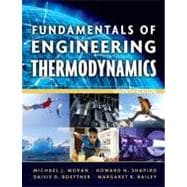Fundamentals of Engineering Thermodynamics maintains its engaging, readable style while presenting a broader range of applications that motivate engineers to learn the core thermodynamics concepts. Two new coauthors help update the material and integrate engaging, new problems.
This leading text uses many relevant engineering-based situations to help students model and solve problems.
Throughout the chapters, they focus on the relevance of thermodynamics to modern engineering problems. Many relevant engineering based situations are also presented to help engineers model and solve these problems.









